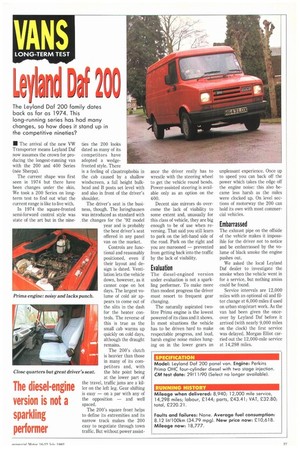VANS
Page 29

If you've noticed an error in this article please click here to report it so we can fix it.
LONG-TERM TEST The Leyland Daf 200 family dates back as far as 1974. This long-running series has had many changes, so how does it stand up in the competitive nineties?
• The arrival of the new VW Transporter means Leyland Daf now assumes the crown for producing the longest-running van with the 200 and 400 Series (nee Sherpa).
The current shape was first seen in 1974 but there have been changes under the skin. We took a 200 Series on longterm test to find out what the current range is like to live with, In 1974 the square-fronted semi-forward control style was state of the art but in the nine
ties the 200 looks dated as many of its competitors have adopted a wedgefronted style. There is a feeling of claustrophobia in the cab caused by a shallow windscreen, a full height bulkhead and B posts set level with and also in front of the driver's shoulder.
The driver's seat is the business, though. The Isringhausen was introduced as standard with . the changes for the '92 model year and is probably the best driver's seat offered in any panel van on the market.
Controls are functional and reasonably positioned, even if their layout and design is dated. Ventilation lets the vehicle down, however, as it cannot cope on hot days. The largest volume of cold air appears to come out of the slits in the dash for the heater controls. The reverse of this is true as the small cab warms up quickly on cold days, although the draught remains.
The 200s clutch is heavier than those in many of its competitors and, with the bite point being at the lower part of the travel, traffic jams are a killer on the left leg. Gear shifting is easy — on a par with any of the opposition — and well spaced.
The 200's square front helps to define its extremities and its narrow track makes the 200 easy to negotiate through town traffic. But without power assist
ance the driver really has to wrestle with the steering wheel to get the vehicle round bends. Power-assisted steering is available only as an option on the 400.
Decent size mirrors do overcome the lack of visibility to some extent and, unusually for this class of vehicle, they are big enough to be of use when reversing. That said you still learn to park on the left-hand side of the road. Park on the right and you are marooned — prevented from getting back into the traffic by the lack of visibility.
Evaluation
The diesel-engined version under evaluation is not a sparkling performer. To make more than modest progress the driver must resort to frequent gear changing.
The naturally aspirated twolitre Prima engine is the lowest powered of its class and it shows. In most situations the vehicle has to be driven hard to make respectable progress, and loud, harsh engine noise makes hanging on in the lower gears an unpleasant experience. Once up to speed you can back off the power which takes the edge off the engine noise; this also became less harsh as the miles were clocked up. On level sections of motorway the 200 can hold its own with most commercial vehicles.
Embarrassed
The exhaust pipe on the offside of the vehicle makes it impossible for the driver not to notice and be embarrassed by the volume of black smoke the engine pushes out.
We asked the local Leyland Daf dealer to investigate the smoke when the vehicle went in for a service, but nothing amiss could be found.
Service intervals are 12,000 miles with an optional oil and filter change at 6,000 miles if used on urban stop/start work. As the van had been given the onceover by Leyland Daf before it arrived (with nearly 9,000 miles on the clock) the first service was delayed. Morgan Elliot carried out the 12,000-mile service at 14,298 miles.
















































































